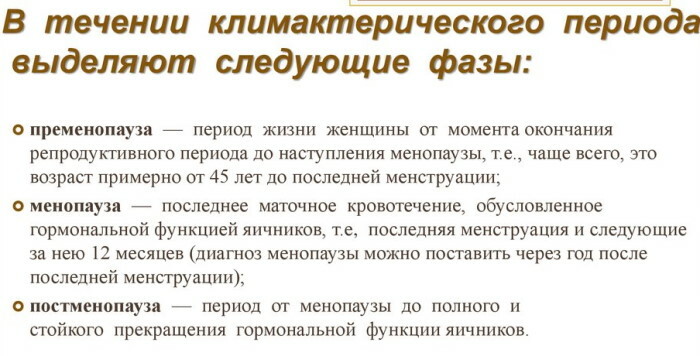Content
- Indications
- Contraindications
- Possible complications
- Training
- Procedure step by step
- Procedure for babies
- Carrying out the procedure for children from 1 year old
- Anterior endoscopy
- Posterior endoscopy
- Care procedures after
- How long will the result last
- Advantages and disadvantages
- Video about nasopharyngeal endoscopy
Endoscopy is a diagnostic procedure that is performed on an outpatient or inpatient basis. Examination of the nasopharynx through an endoscope involves taking biological material for bacteriological analysis, assessing the state of the mucous membrane, the presence or absence of neoplasms in the cavity.
Examination of the nasal cavity and larynx in children (the price depends on the regions) using an endoscope has become widespread due to the speed and versatility of the method. The procedure takes only a few minutes, after which the patient can immediately go home.
The range of prices for the procedure is from 500 to 2000 rubles. depending on the region and other factors.
Indications
Optical fiber helps ENT doctors to examine areas that cannot be seen with normal eyes, such as the inside of the nasal cavity, throat or speech apparatus.
The advantage of fibers is that they are flexible and have a small diameter, which means that they are easy to manipulate in several directions, which allows visualization of limited areas, makes it possible to pass through the nose and reach the bottom pharynx. However, flexible endoscopy requires the use of an instrument with two hands and is therefore a more complex procedure.
Rigid endoscope provides excellent image clarity, facilitates seeding and tissue sampling, better controls nosebleeds and enables the endoscopist to perform surgical intervention. Rigid nasal endoscopes come in a range of 2.7-4 mm in diameter and are tipped at different angles to allow the physician to visualize different areas in the nasal cavity and sinuses.
Nasal endoscopy involves the assessment of the nasal passages and sinuses with direct vision using high quality magnified images. This procedure is usually performed in an otolaryngologist's office and serves as an objective diagnostic tool. The procedure can be performed using a rigid or flexible fiber optic endoscope.
- An endoscopy can show specific details such as the site of bleeding and swelling of the nasal tissue.
- The procedure is used to examine a neoplasm that may be cancer.
- In some cases, it is used to remove a foreign object from a child's nose.
- The doctor may also advise an endoscopy to find out how treatments for nasal or sinus problems work. For example, you can observe the change in the size of polyps.
- Rhinosinusitis is one of the most common causes of nasal endoscopy.

- The procedure can collect pus from an infected area to determine the source of the infection and how to treat it.
Endoscopy of the nasopharynx for children (the price is specified in advance) is assessed as minimally invasive surgery. The procedure is performed in a hospital or surgery center. The operation is performed using very small instruments and does not require an external incision.
The appointment of nasopharyngeal endoscopy occurs with the existing difficulties in establishing a diagnosis.
The most common symptoms to be addressed include:
- purulent or bloody discharge from the nasal passages;
- frequent throbbing pains in the forehead, temples;
- enduring nasalness;
- prolonged nasal congestion;
- snoring at night;
- change, violation or complete absence of smell, taste;
- unclear etiology of chronic rhinitis;
- clarification of the presence of adenoiditis;
- tinnitus or hearing loss;
- frequent exacerbation of sinusitis;
- frontal sinusitis in the chronic stage;
- hypertrophy of polyps on the back of the nasopharynx;
- unidentified causes of puffiness of the face and neck;
- violation of nasal breathing due to deformation of the nasal septum;
- frequent infection with acute respiratory infections;
- examination before or after surgery;
- monitoring the effectiveness of treatment;
- confirmation of the diagnosis.
Endoscopy of the nasopharynx for children (the price is approximately the same in all regions of the country) is necessary before surgery to remove obstructing nasal breathing polyps, tumors, or adenoids.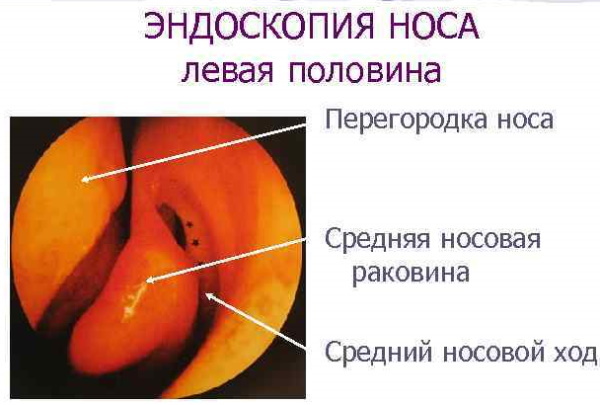
A significant advantage of the survey is the absence of age restrictions. Depending on the age of the child, only the technique of performing the procedure changes.
Contraindications
Before carrying out the diagnostic procedure, the doctor is obliged to clarify the individual physiological properties of the child.
The study is prohibited with a history of features:
- the possibility of bleeding when the endoscope is inserted due to increased sensitivity of the mucous membrane;
- pathological narrowing of the nasal passages;
- the presence of an allergic reaction to local anesthetic drugs, for example, lidocaine, novocaine;
- existing mental disorders;
- the inability to put the child to bed with his inappropriate behavior;
- the presence of congenital malformations of the nasopharynx, creating conditions impossible for the passage of the endoscope;
- fungal infections of the mucous membranes of the respiratory organs;
- narrowing of the nasal passages due to pronounced edema of the mucous membrane;
- nosebleeds of unknown etiology;
- feverish condition of the child;
- sepsis or serious illness;
- condition after resuscitation.
If the child has frequent bleeding due to excessive sensitivity of the mucous membrane, it is necessary to inform the doctor. This will affect the choice of the device, and in this case a thinner device will be used.
In the presence of convulsive movements or other neurological conditions, it is possible to use sedatives.
Possible complications
Despite the simplicity of the procedure, complications may arise during the examination:
- In the absence of proper explanation or parental support, the child's behavior becomes the cause of harm. Sudden head movements or the inability of parental control over the situation leads to blockage of the nasal passages and difficulty breathing.
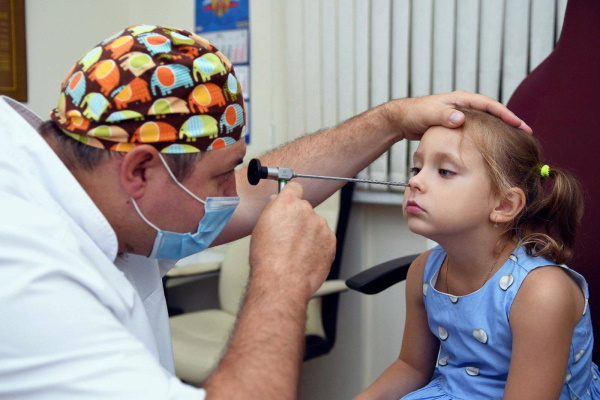
Endoscopy of the nasopharynx for children - The wrong choice of anesthetic aid due to hiding information about the presence of allergic reactions in a child is the cause of the development of anaphylactic shock. In this case, the procedure is urgently interrupted and the patient is injected with an approved antihistamine.
During an endoscopic examination, a physician with little experience may face difficulties:
- when passing narrow nasal passages;
- damage to the mucous membrane and the development of bleeding:
- inept actions that increase the patient's discomfort and stretch the time of manipulation;
- error in misinterpreting the location of the focus of the disease and its incorrect identification.
Violation of the rules for processing endoscopic equipment is one of the reasons for the spread of infectious processes. The endoscope should be treated with antiseptic solutions immediately before the start of the procedure in the presence of patients.
In addition to the lack of antiseptic treatment, excess of the procedure can also affect the quality of the procedure. When using the endoscope until it dries completely after applying antiseptic agents, it is possible to get a chemical burn of the mucous membrane.
Insufficient use of anesthetic drug leads to increased discomfort during the study. However, competent patient preparation, handling and preparation of equipment, together with the competence of the doctor, reduce the risks of complications to a minimum. With a favorable course of the procedure, the discomfort in the nasal cavity disappears within a few minutes.
Training
Endoscopy of the nasopharynx does not require specific preparation. For research, parents can contact a local diagnostic center, the price of which will depend on the region. If the child is in the hospital, then the research is carried out free of charge.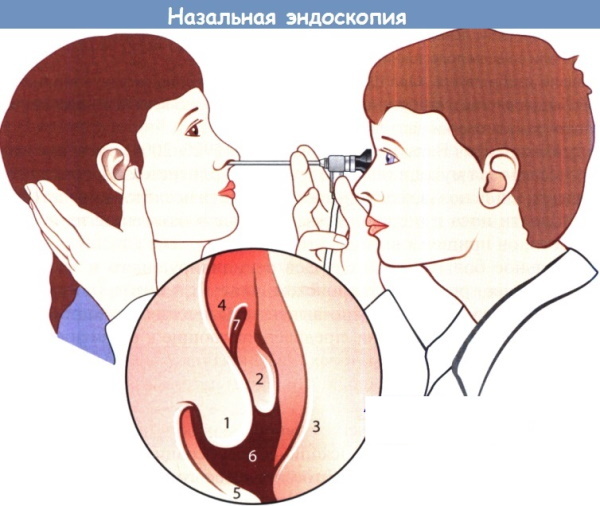
Before the procedure, children can drink and eat as needed.
In any case, you should ask your doctor if you should stop taking any medications before the procedure. These may include blood thinners. The preparation process for endoscopic examination of the nasopharynx should take place with the interaction of the doctor and parents. The psychological attitude of a child is important for a trusting relationship with a doctor.
Parents should explain to the child the need for the procedure and its nature. A detailed explanation of the medical procedures will reduce fear and discomfort during the examination.
Immediately before the procedure, a topical agent is sprayed into the nose. This reduces swelling and allows the endoscope to easily pass through the nasal cavity and sinuses. Anesthetic is also sprayed into the nose, which makes the procedure briefly easier.
Procedure step by step
Before conducting an endoscopic examination, the child needs to be monitored by an ENT doctor, who assesses the severity of the disease and the need for intervention. Endoscopy of the nasopharynx is performed only if indicated.
- The child is seated in a chair or on the lap of a parent in case of need for moral and psychological support. To facilitate the procedure, the head must be fixed.
- Before inserting the endoscope, the doctor examines the vestibule of the nose for the presence of inflammation or purulent discharge. After that, vasoconstrictor drugs and pain relievers in the form of a spray are applied to the mucous membrane.
- Before starting the study, the equipment should be treated with an antiseptic agent. When the endoscope is completely dry, an anesthetic is applied in the form of a gel.
- The endoscope is gently inserted into the nasal passage.
- By slowly advancing the endoscopic tube, the doctor reaches the examination site. An enlarged image of organs is displayed on the monitor, and the state of the mucous membrane is assessed. In doubtful places, the image can be enlarged up to 30 times and printed.
- When the endoscope moves, there is a slight, non-hazardous pressure on the mucous membrane, however, the child should be warned about this and helped to remain calm.
- Using a flexible instrument will not injure or scratch the nasal passages.
In the process of examining the areas under study, the doctor can additionally conduct tissue sampling to diagnose the cytological picture of the pathological formation. It is also possible to remove neoplasms if this does not lead to severe bleeding or trauma to the mucous membrane.
Endoscopy of the paranasal sinuses and nasopharyngeal cavity includes the following viewing algorithm:
- Panoramic examination of the general nasal passage and the anterior part of the nose.
- The mouth of the Eustachian tube is checked. Check the condition of the nasopharynx, the presence of adenoid vegetation.
- As the apparatus moves into the middle nasal concha, the state of the mucous membrane and the middle nasal passage is assessed.
- Examine the upper nasal passage, the outlet of the maxillary sinus and the olfactory fissure.
On average, the procedure takes 5 to 15 minutes. If necessary, the diagnosis is supplemented with therapeutic or surgical procedures (for example, removal of polyps). After examining the nasopharynx, the doctor prints the images and makes a conclusion. The endoscopy results are passed on to the patient or sent to the attending physician.
When examining the nasopharynx, the expert evaluates:
- The presence of inflammation or hypertrophy.
- The color of the mucous membrane.
- Type of discharge (clear, liquid, purulent, thick, mucous).
- The presence of anatomical diseases of the nasopharynx (curvature of the nasal septum, narrowing of the passages).
- The presence of tumor formations, polyps.
Procedure for babies
Endoscopy of the nasopharynx for children (the price does not depend on the age of the child) of the infant period is performed at the moment when he is in a horizontal position. The child's head and body must be secured by the parents to avoid possible chaotic movements. In this position, the doctor introduces the endoscope and analyzes the state of the ENT organs. There is no need to specially prepare for the procedure.
Carrying out the procedure for children from 1 year old
To facilitate the examination, the child is placed on the parent's lap and his head is tilted back. The maximum extension of the air supply channels facilitates the penetration and advancement of the endoscope into the nasopharyngeal cavity. The head fixed in this position is the optimal position for endoscopy.
In the process of visualization of the vestibules of the nasal cavity, the mucous membrane of the turbinates, the mouths of the canals paranasal sinuses, nasopharynx and the orifices of the auditory tubes, pathological changes are recorded by creating pictures.
The examination procedure depends on the presumptive diagnosis. Distinguish between anterior and posterior endoscopy.
Anterior endoscopy
Before starting the procedure, the doctor will examine the nasopharyngeal cavity for ulcers or inflammation. Anterior endoscopy is performed in two head positions - straight or tilted back. In the first case, it is possible to examine the anterior and posterior parts of the nasal cavity and septum. When the head is thrown back, the middle sections of the nose and the nasal passage are examined. With a high qualification of the doctor, the child will not experience unpleasant sensations during the endoscopic examination.
In pediatric practice, in most cases, an anterior rhinoscopy is performed, since the posterior technique is more complicated. In the case of hypertrophy of the tonsils or edema of the mucous membrane, difficulties during endoscopy are not excluded.
Posterior endoscopy
Posterior endoscopy is a technically more complex diagnostic technique that requires the skills and training of a physician. Using this technique, the distant parts of the nasopharynx, the fornix and its sides are studied. At the beginning of the study, the doctor presses the child's tongue with a medical spatula and inserts a pre-warmed speculum into the nasopharynx. The subsequent technique does not differ from anterior endoscopy and involves the penetration of the probe through the nasal passages.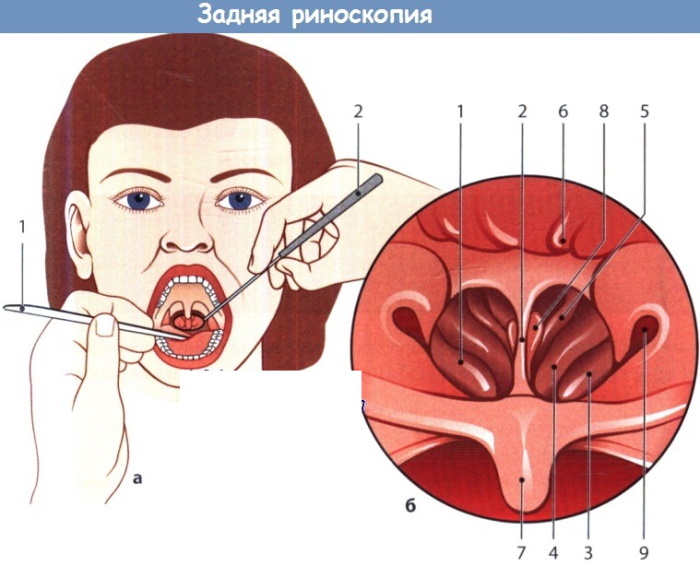
At the end of the procedure, the endoscope is removed from the nasal canals, and the result is issued together with the conclusion of the ENT doctor and the diagnosis. The examination result can be saved and recorded on an external medium, CD or DVD.
Care procedures after
At the end of the endoscopy, recommendations for care are to avoid actions that increase blood pressure for 12 hours. Any physical activity is excluded, you should not fly by plane immediately after the procedure. Microtrauma inflicted during the examination can contribute to the development of bleeding with an increase in pressure.
Immediately after the procedure, it is recommended to refrain from eating until the effect of the application anesthesia wears off.
If neoplasms were removed during the endoscopic examination, it is necessary to observe the home regimen for 3-7 days.
How long will the result last
Endoscopy of the nasopharynx for children (the price is focused on the average consumer) as a re-examination is necessary in several cases. For example, to monitor the condition of the sinuses after surgery or therapy. In case of recurrent complaints, endoscopy can be repeated.
Advantages and disadvantages
A feature of the endoscopic examination is practically no drawbacks.
| Benefits of the procedure | Informativeness of the method, allowing in 90% of cases to establish the final diagnosis. |
| Possibility of examining hard-to-reach areas of the nose without surgery. | |
| Short duration of manipulations. | |
| The harmlessness of the procedure. | |
| Assessment of the condition in real time and the issuance of the result immediately after the end of the procedure. | |
| Possibility of painless monitoring of the state of ENT organs after surgical interventions. | |
| No radiation exposure, unlike radiography. | |
| Flaws | Lachrymation and sneezing. |
| Possible development of bleeding. | |
| A sore throat. | |
| Swelling of the larynx and throat. | |
| Hyperemia of the mucous membrane. | |
| Itching in the throat. | |
| Shortness of breath. |
Endoscopic examination of the nasopharynx is the "gold" diagnostic standard. The procedure proved to be more reliable in identifying all obstructive nasopharyngeal processes. Thanks to the device, the doctor sees the hard-to-reach parts of the respiratory tract to the smallest detail.
Endoscopy for children is performed when it is not enough to carefully examine the nasopharynx using mirrors to make an accurate diagnosis. The examination is carried out in medical centers or specialized clinics equipped with special equipment licensed to provide such services. The price depends on the location of medical institutions in the area, the complexity of the manipulation, the professionalism of the doctor and other factors.
Video about nasopharyngeal endoscopy
Endoscopy of the nasopharynx:


